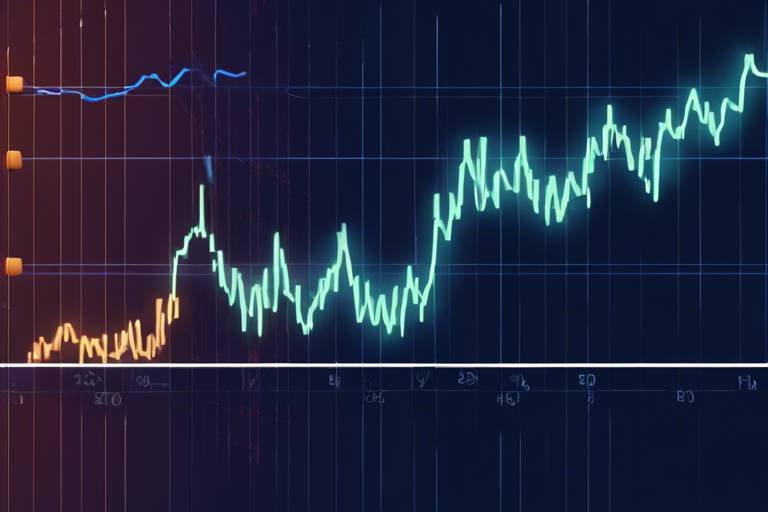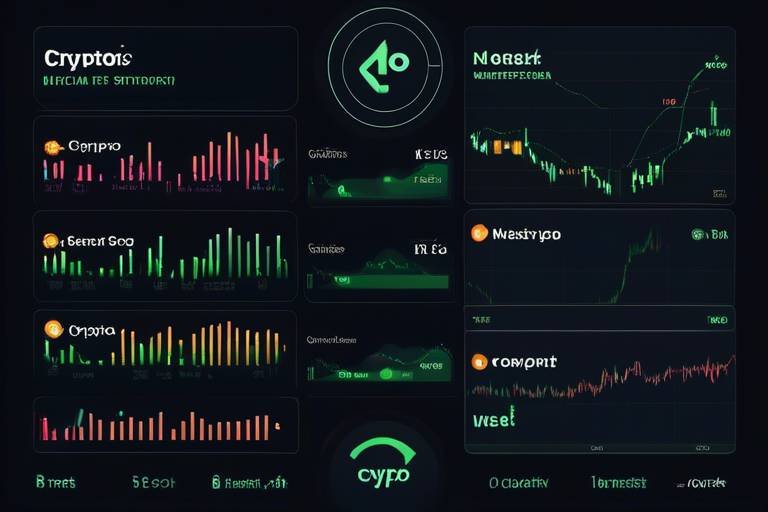Interpreting RSI - A Guide for Crypto Traders
The world of cryptocurrency trading can often feel like navigating a stormy sea. One moment, you're riding high on profits, and the next, you're battling the waves of market volatility. In this turbulent environment, having the right tools at your disposal can make all the difference. One such tool is the Relative Strength Index (RSI), a powerful momentum oscillator that provides traders with valuable insights into market conditions. Understanding how to interpret RSI can empower you to make informed trading decisions, helping you to spot potential reversals and capitalize on market trends.
So, what exactly is RSI? In simple terms, it's a technical indicator that measures the speed and change of price movements. This means it can help you gauge whether a cryptocurrency is overbought or oversold, which is crucial for timing your trades effectively. The RSI operates on a scale from 0 to 100, with values typically above 70 indicating an overbought condition and values below 30 suggesting an oversold condition. However, the interpretation of these values isn't always black and white. As you delve deeper into RSI, you'll discover that context matters—a lot!
As a trader, you want to be ahead of the curve, and that's where understanding the nuances of RSI comes into play. For instance, if you notice that a coin's RSI is above 70, it might be tempting to think that a price drop is imminent. But what if the coin is in a strong uptrend? In such cases, the RSI can remain elevated for extended periods. This is why it's essential to combine RSI readings with other market indicators to get a clearer picture of the market landscape.
In the following sections, we'll explore how to calculate RSI, interpret its values, and even identify divergence strategies that can signal potential price reversals. By the end of this guide, you'll be equipped with the knowledge you need to harness the power of RSI in your trading strategy. Ready to dive in? Let's get started!
The Relative Strength Index is not just a random number; it’s a carefully calculated indicator that reflects market momentum. To grasp its significance, it’s essential to understand its calculation, scale, and the meaning behind overbought or oversold conditions. The RSI is derived from the average gains and losses over a specified period, typically 14 days. This calculation helps to smooth out price movements and provides a clearer picture of market momentum.
When the RSI reaches extreme levels, it can indicate potential market reversals. For example, if the RSI climbs above 70, it suggests that the asset may be overbought, signaling a potential pullback. Conversely, an RSI below 30 indicates that the asset could be oversold, which might present a buying opportunity. However, it’s crucial to remember that these signals should not be taken at face value. Always consider the broader market context and combine RSI with other indicators for a comprehensive analysis.
Calculating the RSI might seem daunting at first, but it’s quite straightforward once you break it down. The formula involves determining the average gains and losses over a specific period. Let’s take a closer look at how to compute the RSI effectively.
The RSI formula is expressed as follows:
RSI 100 - (100 / (1 + RS))
Where RS (Relative Strength) is the average gain of up periods during a specified time frame divided by the average loss of down periods over the same time frame. This formula helps to create a smooth oscillating value between 0 and 100.
To calculate the average gain and average loss, you need to follow these steps:
- Calculate the daily price changes.
- Separate the gains and losses.
- Calculate the average gain and average loss over the chosen period.
This methodology is crucial because it lays the foundation for accurate RSI readings, which can ultimately influence your trading strategies.
The time period you choose for RSI calculation can significantly impact your analysis. While the standard period is 14 days, some traders prefer shorter or longer periods based on their trading style. For instance:
- A shorter period (like 7 days) may generate more signals but can also lead to false positives.
- A longer period (like 21 days) can smooth out fluctuations but may lag behind the market trends.
Choosing the right time frame is about finding a balance that suits your trading strategy and risk tolerance.
Interpreting RSI values is essential for making informed trading decisions. A high RSI value (above 70) may indicate that an asset is overbought, while a low value (below 30) suggests it is oversold. However, these levels are not absolute. Market conditions can influence how RSI behaves, making it essential to consider other factors before acting on these signals.
RSI divergence occurs when the price of an asset moves in the opposite direction of the RSI. This can signal potential reversals in price trends. For instance, if the price is making new highs but the RSI is failing to do so, it could indicate a weakening trend, suggesting a possible price drop.
Understanding the difference between regular and hidden divergence is key for traders. Regular divergence signals a potential reversal, while hidden divergence can indicate a continuation of the current trend. Recognizing these patterns can significantly enhance your trading strategy.
Integrating RSI with other technical indicators can provide a more comprehensive market analysis. For example, using RSI alongside moving averages can help confirm trends and identify entry or exit points. This combination allows traders to make more informed decisions and improve their overall trading effectiveness.
1. What is the best RSI setting for cryptocurrency trading?
While the standard setting is 14 periods, the best setting can vary based on your trading style. Experiment with different periods to find what works best for you.
2. Can RSI be used for all cryptocurrencies?
Yes, RSI can be applied to any cryptocurrency, but its effectiveness may vary based on market conditions and volatility.
3. How often should I check RSI values?
This depends on your trading style. Day traders may check RSI values multiple times a day, while long-term traders may check them weekly.

Understanding RSI Basics
The Relative Strength Index (RSI) is a powerful tool in the arsenal of any crypto trader. It’s essentially a momentum oscillator that helps you gauge the speed and change of price movements. Think of it as a pulse check for the market, giving you insights into whether an asset is overbought or oversold. The RSI operates on a scale from 0 to 100, and typically, readings above 70 suggest that an asset is overbought, while readings below 30 indicate that it is oversold. This can be crucial for making timely trading decisions, as it helps you identify potential reversal points.
To truly understand the RSI, it's important to grasp its calculation and underlying mechanics. The RSI is calculated using the average gains and average losses over a specified period, most commonly 14 days. This means that the RSI takes into account the price movements of an asset over the last two weeks, providing a snapshot of its momentum. The formula might seem complex at first, but once you break it down, it becomes much easier to apply in your trading strategies.
One of the key aspects of the RSI is its ability to highlight potential market conditions. When the RSI is above 70, it suggests that traders might be getting a bit too enthusiastic, pushing prices higher without sufficient backing from fundamental factors. Conversely, when the RSI dips below 30, it can indicate that the market is overly pessimistic, potentially setting the stage for a price bounce. Understanding these thresholds can help traders make more informed decisions about when to enter or exit trades.
In addition to its basic functionality, the RSI can also be used in conjunction with other indicators to enhance trading effectiveness. For instance, combining the RSI with moving averages can provide a more comprehensive view of market trends. This approach allows traders to confirm signals and reduce the likelihood of false positives, which can be a common pitfall in trading.
In summary, the Relative Strength Index is not just a number; it's a valuable indicator that can guide your trading decisions. By understanding how it works and what it signifies, you can navigate the often turbulent waters of crypto trading with greater confidence and precision. So, whether you're a seasoned trader or just starting, incorporating RSI into your toolkit can be a game changer.

How to Calculate RSI
Calculating the Relative Strength Index (RSI) might sound like a daunting task, but once you break it down, it’s easier than pie! The RSI is a momentum oscillator that ranges from 0 to 100, and it helps traders identify whether a cryptocurrency is overbought or oversold. So, how do we get to that all-important number? Let’s dive into the nitty-gritty of the calculation.
The first step in calculating RSI is to determine the average gains and average losses over a specific time period. Typically, traders use a 14-day period, but you can adjust this based on your trading strategy. The formula for calculating the RSI is:
RSI 100 - (100 / (1 + RS))
Here, RS (Relative Strength) is calculated by dividing the average gain by the average loss. But before you can even get to that point, you need to calculate the average gains and losses. Let’s break that down further!
The formula for calculating RSI can seem a bit complex at first glance, but it's all about understanding the components. To calculate the average gain and average loss:
- Average Gain: This is the average of all the gains during the specified period. If there were no gains, then the average gain is 0.
- Average Loss: Similarly, this is the average of all the losses during that same period. If there were no losses, the average loss is 0.
To find these averages, you would typically sum the gains and losses over the 14-day period and then divide by 14. If you want to be more precise, you can use a smoothing technique, which involves applying a formula that takes the previous average into account:
Average Gain [(Previous Average Gain) x 13 + Current Gain] / 14 Average Loss [(Previous Average Loss) x 13 + Current Loss] / 14
Once you have your average gain and average loss, plug those values into the RS formula. It’s like putting together a puzzle; each piece fits perfectly to reveal the bigger picture!
Choosing the right time period for your RSI calculation can make all the difference. While the standard period is 14 days, some traders prefer shorter or longer periods depending on their trading style. For instance:
- Shorter periods (like 7 days) can make the RSI more sensitive and provide more signals, but they can also lead to false positives.
- Longer periods (like 21 days) tend to smooth out the RSI, making it less reactive to price changes, which might be beneficial for long-term traders.
Ultimately, testing different periods and seeing what works best for you can help refine your trading strategy. Just remember, there’s no one-size-fits-all approach in the world of crypto trading!
In conclusion, calculating the RSI involves understanding the relationship between gains and losses over a chosen period. By mastering this calculation, you equip yourself with a powerful tool to navigate the often turbulent waters of cryptocurrency trading. Now, let’s move on to interpreting those RSI values!
- What is the best time period for calculating RSI? While 14 days is the standard, it ultimately depends on your trading style. Experiment with different periods to see what yields the best results for you.
- How can I use RSI in my trading strategy? Use RSI to identify overbought or oversold conditions. Generally, an RSI above 70 indicates overbought conditions, while an RSI below 30 suggests oversold conditions.
- Can RSI be used in conjunction with other indicators? Absolutely! Combining RSI with other indicators like moving averages or MACD can provide a more comprehensive market analysis.

RSI Formula Breakdown
The Relative Strength Index (RSI) is more than just a number; it's a powerful tool that helps traders gauge the momentum of a cryptocurrency's price movement. To truly harness the potential of the RSI, it's essential to understand its formula and components. At its core, the RSI is calculated using the average gains and average losses over a specified period, typically 14 days. The formula can be broken down into a few simple steps, which we'll explore in detail.
First, let's look at the basic formula for calculating RSI:
RSI 100 - (100 / (1 + RS))
In this formula, RS (Relative Strength) is the average of 'n' days' up closes divided by the average of 'n' days' down closes. This is where understanding average gains and losses comes into play, which we will delve into next.
To calculate the average gain and average loss, you need to follow a specific methodology:
- Determine the gains and losses over the selected period (e.g., 14 days).
- For each day, if the price increased, record the gain; if it decreased, record the loss.
- At the end of the period, compute the average gain and average loss by dividing the total gains and losses by the number of periods.
For example, if over a 14-day period, the total gains amount to 70 and the total losses amount to 30, the calculations would be:
Average Gain Total Gains / 14 70 / 14 5
Average Loss Total Losses / 14 30 / 14 2.14
This gives you a clear picture of the average movement of the asset over that timeframe, which is crucial for calculating the RS.
Choosing the right time period for your RSI calculation is another critical aspect that can significantly affect your analysis. While the standard period is 14 days, some traders prefer shorter or longer periods. A shorter period, like 7 days, may make the RSI more sensitive to price changes, leading to more signals, but it can also result in more noise and false signals. Conversely, a longer period, such as 21 days, smooths out the fluctuations but may delay signals. It's essential to find a balance that suits your trading style and the specific crypto asset you are analyzing.
In summary, understanding the RSI formula and its components is vital for effective trading. By mastering the calculations of average gains and losses and being mindful of the time period you select, you can utilize the RSI to make informed trading decisions that can enhance your overall strategy.

Average Gain and Loss
Understanding is crucial for calculating the Relative Strength Index (RSI) effectively. At its core, the RSI formula relies on the average gains and losses over a specified period, typically 14 days. This means that to compute the RSI, you first need to determine how much the price has increased or decreased during that timeframe. Think of it like measuring the ups and downs of a roller coaster ride—each peak represents a gain, while each valley signifies a loss.
To calculate the average gain and average loss, you can follow these steps:
- Identify the closing prices for the asset over the chosen period.
- Calculate the daily gains and losses by comparing the current day's closing price to the previous day's closing price.
- For days where the price increased, record the gain; for days where it decreased, record the loss. If there is no change, it is recorded as zero.
- Sum the total gains and total losses over the period.
- Finally, divide the total gains by the number of days with gains to find the average gain, and do the same for losses to find the average loss.
Here’s a simple table to illustrate how this works:
| Day | Closing Price | Gain/Loss |
|---|---|---|
| 1 | $100 | - |
| 2 | $105 | +5 |
| 3 | $103 | -2 |
| 4 | $107 | +4 |
| 5 | $110 | +3 |
In this example, you would sum the gains (+5, +4, +3) to get a total gain of 12, and the losses (-2) to get a total loss of 2. To find the average gain, you would divide the total gain by the number of days with gains (3), resulting in an average gain of 4. The average loss would be 2 divided by 1 (since there was only one losing day), giving you an average loss of 2.
Once you have the average gain and average loss, you can use them in the RSI formula: RSI 100 - (100 / (1 + (Average Gain / Average Loss))). This formula will yield a value between 0 and 100, which can then be interpreted to determine whether the asset is overbought or oversold. Understanding this process is not just about numbers; it’s about gaining insights into market behavior and making informed trading decisions.

Time Period Selection
Selecting the appropriate time period for calculating the Relative Strength Index (RSI) is crucial for obtaining accurate and meaningful readings. The time period you choose can significantly influence the sensitivity of the RSI to price movements. For instance, a shorter time frame may result in a more volatile RSI, while a longer time frame can smooth out fluctuations and provide a clearer picture of the overall trend. So, how do you decide which time period to use?
Typically, the default setting for RSI is 14 periods, which many traders find effective. This means that the RSI is calculated based on the price movements over the last 14 candlesticks. However, this isn't a one-size-fits-all solution. Depending on your trading style—whether you are a day trader, swing trader, or long-term investor—you might want to adjust this period.
Here’s a quick breakdown of common time periods and their implications:
| Time Period | Type of Trader | Implications |
|---|---|---|
| 5 periods | Day Traders | Highly sensitive to price changes; can signal quick trades but may lead to false signals. |
| 14 periods | Swing Traders | Balanced approach; captures medium-term trends effectively. |
| 30 periods | Long-term Investors | Smoother RSI; better for identifying long-term trends but may miss short-term opportunities. |
When choosing the right time period, consider the following factors:
- Your Trading Style: Are you looking for quick trades or long-term investments? Adjust your time frame accordingly.
- Market Conditions: In highly volatile markets, shorter periods may give you more timely signals, while stable markets may benefit from longer periods.
- Backtesting Results: Experiment with different periods and analyze historical data to see which settings yield the best results for your strategy.
Ultimately, the key is to find a balance that aligns with your trading goals. Don’t be afraid to experiment and adjust your time periods as you gain more experience and insight into market behavior. Remember, the RSI is just one tool in your trading toolbox, and its effectiveness will largely depend on how well you integrate it into your overall strategy.
1. What is the ideal time period for RSI?
The ideal time period varies based on your trading style. Day traders often use shorter periods (like 5), while swing traders typically stick to the standard 14, and long-term investors may prefer longer periods (like 30).
2. Can I customize the RSI settings?
Yes! Most trading platforms allow you to customize the RSI settings to suit your trading style and preferences.
3. How does the time period affect RSI readings?
Shorter time periods can create more volatile RSI readings, leading to more signals, but they may also increase the likelihood of false signals. Conversely, longer periods provide smoother readings but can lag behind price movements.
4. Should I always stick to the default 14 periods?
Not necessarily. While 14 periods is a popular choice, it’s essential to experiment with different time frames to see which works best for your trading approach.

Interpreting RSI Values
The Relative Strength Index (RSI) is a powerful tool in the arsenal of any crypto trader. Understanding how to interpret RSI values is crucial for making informed trading decisions. The RSI operates on a scale of 0 to 100, providing insights into whether an asset is overbought or oversold. Typically, an RSI value above 70 indicates that an asset is overbought, suggesting that a price correction may be on the horizon. Conversely, an RSI value below 30 indicates that an asset is oversold, which could signal a potential buying opportunity.
To put it simply, think of the RSI as a weather forecast for the crypto market. Just as a high temperature might indicate a heatwave, a high RSI suggests that a coin is experiencing a surge in buying pressure. On the flip side, a low RSI could be akin to a cold front, indicating that sellers may be dominating the market. Traders often look for RSI values to confirm their market sentiment. For example, if the RSI is above 70 and the price continues to rise, it could be a sign of a bubble, while a falling price with an RSI below 30 might indicate a potential bottom.
Moreover, the interpretation of RSI values isn’t just about the numbers themselves; it’s also about the context in which they occur. For instance, if the price of a cryptocurrency is climbing, but the RSI is declining, this divergence could signal a weakening trend. This situation is akin to a car speeding down a hill without brakes—eventually, it’s going to crash. Traders should be alert to these signals, as they can provide early warnings of potential trend reversals.
Here’s a quick reference table summarizing RSI values and their implications:
| RSI Value | Market Condition | Implication |
|---|---|---|
| 0 - 30 | Oversold | Potential buying opportunity |
| 30 - 70 | Neutral | Market is balanced; wait for confirmation |
| 70 - 100 | Overbought | Potential selling opportunity |
Additionally, traders often use RSI in conjunction with support and resistance levels to enhance their analysis. For instance, if the RSI is indicating overbought conditions while the price approaches a known resistance level, this could strengthen the case for a potential price reversal. Similarly, an oversold RSI at a support level might bolster the argument for a price bounce back.
In conclusion, interpreting RSI values is not just about looking at the numbers but understanding the broader market context. By combining RSI analysis with other technical indicators and market trends, traders can develop a more comprehensive view of the market, enhancing their chances of making profitable trades.
- What is the best time period for calculating RSI? The most common period used is 14 days, but traders can adjust this based on their trading strategy.
- Can RSI be used for all cryptocurrencies? Yes, RSI can be applied to any asset that has price movements, including stocks, forex, and cryptocurrencies.
- How often should I check RSI values? It depends on your trading style; day traders may check it multiple times a day, while swing traders might look at it daily or weekly.

RSI Divergence Strategies
The concept of RSI divergence is a powerful tool in the arsenal of any crypto trader. It serves as a beacon, signaling potential reversals in price trends. But what exactly is divergence? In simple terms, it occurs when the price of an asset moves in one direction, while the RSI indicator moves in the opposite direction. This dissonance can hint at weakening momentum, suggesting that a trend may soon reverse. For traders, recognizing these divergences can be the difference between a successful trade and a missed opportunity.
To effectively utilize RSI divergence, it's essential to understand how to identify it. There are two primary types of divergence: regular divergence and hidden divergence. Each has its unique characteristics and implications for trading strategies. Regular divergence typically indicates potential reversals, while hidden divergence suggests that a trend is likely to continue. By mastering these concepts, traders can better position themselves to capitalize on market movements.
When looking for divergence, traders should focus on key price points and corresponding RSI levels. For example, if the price reaches a new high, but the RSI fails to do so, that’s a classic case of regular bearish divergence. Conversely, if the price makes a lower low but the RSI makes a higher low, it indicates regular bullish divergence. These signals can be visualized in a chart, making it easier to spot potential trading opportunities.
Incorporating RSI divergence into your trading strategy can enhance your decision-making process. Consider the following steps to effectively apply divergence strategies:
- Monitor Price Action: Keep a close eye on price movements and look for instances where the price and RSI diverge.
- Confirm with Other Indicators: Use additional indicators, such as moving averages or MACD, to confirm signals generated by RSI divergence.
- Set Entry and Exit Points: Define clear entry and exit points based on your analysis to minimize risk and lock in profits.
It's also important to remember that divergence is not a foolproof signal. Market conditions can change rapidly, and false signals can occur. Therefore, it’s wise to use divergence as part of a broader trading strategy that includes risk management techniques. For instance, consider placing stop-loss orders to protect your capital in case the market moves against your position.
In summary, RSI divergence strategies can significantly improve your trading effectiveness by providing insights into potential market reversals. By understanding how to identify and interpret divergences, and by integrating them with other technical indicators, you can create a robust trading plan that adapts to market dynamics. Remember, trading is as much an art as it is a science; the more you practice and refine your skills, the better your outcomes will be.
What is RSI divergence?
RSI divergence occurs when the price of an asset moves in one direction while the RSI indicator moves in the opposite direction, signaling potential reversals in price trends.
How can I identify regular and hidden divergence?
Regular divergence is identified when the price makes a new high or low, but the RSI does not. Hidden divergence occurs when the price makes a lower low or higher high, but the RSI makes a higher low or lower high, indicating trend continuation.
Can RSI divergence be used alone for trading decisions?
While RSI divergence is a powerful tool, it should be combined with other indicators and risk management strategies for more reliable trading decisions.

Regular vs. Hidden Divergence
When diving into the world of trading, especially in the volatile realm of cryptocurrencies, understanding the nuances of price movements is crucial. One concept that traders often grapple with is divergence, which can serve as a powerful tool in predicting potential market reversals. Divergence occurs when the price of an asset moves in the opposite direction of an indicator, such as the RSI. There are two primary types of divergence that traders need to be aware of: regular divergence and hidden divergence. Each type provides unique insights and signals that can dramatically influence trading strategies.
Regular divergence is often viewed as a warning sign; it indicates that the momentum behind a price movement is weakening. For instance, if the price of a cryptocurrency is making new highs but the RSI is failing to follow suit, this discrepancy suggests that the upward momentum is losing steam. Traders may interpret this as a potential signal to consider selling or tightening their stops. Conversely, if the price is making new lows while the RSI is showing higher lows, it can indicate a potential bullish reversal. This type of divergence is particularly valuable because it helps traders identify potential entry points for long positions.
On the other hand, hidden divergence is a different beast altogether. It often signifies a continuation of the current trend. For example, if the price is making higher lows while the RSI is making lower lows, this suggests that the underlying strength of the trend is still intact, even if the indicator is showing weakness. Traders might view this as a signal to stay in their positions or even to add to them. Hidden divergence is a subtle yet powerful indicator that can help traders maintain their positions during what might seem like temporary pullbacks.
| Divergence Type | Indication | Trading Action |
|---|---|---|
| Regular Divergence | Potential trend reversal | Consider selling or tightening stops |
| Hidden Divergence | Continuation of the current trend | Maintain position or consider adding |
To summarize, recognizing the difference between regular and hidden divergence can significantly enhance a trader's ability to navigate the unpredictable waters of cryptocurrency trading. While regular divergence can signal a potential reversal, hidden divergence often reaffirms the strength of the current trend. By paying close attention to these signals, traders can make more informed decisions that align with their trading strategies.
Incorporating these insights into your trading plan can be the difference between a profitable trade and a missed opportunity. After all, in the fast-paced world of crypto, being able to read the signs can help you stay ahead of the curve. So, the next time you're analyzing an asset, take a moment to consider whether you’re witnessing regular or hidden divergence—it could just change the game for you!
- What is divergence in trading? Divergence occurs when the price of an asset moves in the opposite direction of an indicator, signaling potential reversals or continuations.
- How can I identify regular divergence? Regular divergence is identified when price makes new highs or lows, while the RSI shows lower highs or higher lows, indicating weakening momentum.
- What does hidden divergence signify? Hidden divergence suggests that the current trend is likely to continue, often seen when the price makes higher lows while the RSI shows lower lows.
- Can I rely solely on RSI for trading decisions? While RSI is a powerful tool, it's best used in conjunction with other indicators and analysis methods to enhance decision-making.

Combining RSI with Other Indicators
When it comes to trading in the volatile world of cryptocurrency, relying solely on one indicator can often lead to missed opportunities or misguided decisions. That's where the magic of combining the Relative Strength Index (RSI) with other technical indicators comes into play. By integrating RSI with other tools, traders can create a more robust trading strategy that enhances their ability to interpret market conditions accurately.
For instance, consider using RSI in conjunction with Moving Averages (MA). Moving averages smooth out price data to identify trends over a specific period. When RSI indicates an overbought or oversold condition, a trader can look at the moving averages to confirm whether the market is indeed trending in that direction. This dual confirmation can significantly increase the probability of a successful trade.
Another powerful combination is using RSI with MACD (Moving Average Convergence Divergence). While RSI measures momentum, MACD provides insights into the strength and direction of a trend. By analyzing both indicators together, traders can spot potential buy or sell signals with greater confidence. For example, if RSI is showing an oversold condition while MACD is crossing above its signal line, it could indicate a strong buy opportunity.
Moreover, incorporating Bollinger Bands with RSI can also yield fruitful results. Bollinger Bands consist of a middle band (simple moving average) and two outer bands that represent standard deviations. When the price touches the lower Bollinger Band and RSI indicates oversold conditions, it can signal a potential reversal. Conversely, if the price hits the upper band while RSI shows overbought conditions, it might be time to consider selling.
To illustrate these combinations more clearly, let’s look at a simple table summarizing these indicators and their potential synergies:
| Indicator Combination | Purpose | Potential Trading Signal |
|---|---|---|
| RSI + Moving Averages | Identifying trend direction | Confirmation of overbought/oversold conditions |
| RSI + MACD | Strength and direction of momentum | Buy when RSI is low and MACD crosses above |
| RSI + Bollinger Bands | Reversal signals | Buy near lower band with low RSI; sell near upper band with high RSI |
Ultimately, the key to successfully combining RSI with other indicators lies in understanding how they complement each other. Each indicator has its strengths and weaknesses, and by leveraging their unique characteristics, traders can paint a clearer picture of the market landscape. So, the next time you’re analyzing the charts, don’t just stop at RSI; look for those additional indicators that can provide you with that extra layer of insight.
- What is the best indicator to use with RSI? While it varies by trader preference, popular choices include Moving Averages, MACD, and Bollinger Bands.
- Can RSI be used alone? Yes, but combining it with other indicators can enhance its effectiveness and provide more reliable signals.
- What does it mean when RSI is above 70? It typically indicates that an asset is overbought, suggesting a potential price correction.
- How often should I check RSI? It depends on your trading strategy; day traders may check it frequently, while long-term investors might look at it less often.
Frequently Asked Questions
- What is the Relative Strength Index (RSI)?
The Relative Strength Index (RSI) is a momentum oscillator that helps traders gauge the speed and change of price movements in the crypto market. It ranges from 0 to 100 and indicates whether an asset is overbought or oversold, providing crucial insights for trading decisions.
- How do I calculate the RSI?
To calculate the RSI, you need to determine the average gains and losses over a specified period, typically 14 days. The formula involves dividing the average gain by the average loss and then applying the RSI formula: RSI 100 - (100 / (1 + RS)), where RS is the average gain divided by the average loss.
- What do overbought and oversold conditions mean?
Overbought conditions occur when the RSI is above 70, suggesting that the asset may be due for a price correction. Conversely, oversold conditions happen when the RSI is below 30, indicating that the asset might be undervalued and could rebound in price. Understanding these conditions helps traders make more informed decisions.
- What is RSI divergence?
RSI divergence occurs when the price of an asset moves in the opposite direction of the RSI. This can signal potential reversals in price trends. For example, if prices are making new highs while the RSI is making lower highs, it may indicate a weakening trend and a possible price drop.
- How can I use RSI with other indicators?
Combining RSI with other technical indicators, such as moving averages or MACD, can enhance your trading strategy. For instance, using RSI alongside a moving average crossover can provide clearer signals for entry and exit points, allowing for more comprehensive market analysis.
- What are the common time periods used for RSI calculation?
The most commonly used time period for calculating RSI is 14 days, but traders can adjust this based on their trading style. Shorter periods may yield more signals but can also lead to false positives, while longer periods can smooth out the RSI and provide a clearer picture of the overall trend.
- What is the difference between regular and hidden divergence?
Regular divergence signals potential reversals, while hidden divergence indicates that the current trend is likely to continue. For example, if prices make a lower low but the RSI makes a higher low, this is regular divergence, suggesting a potential bullish reversal. On the other hand, if prices make a higher high but RSI makes a lower high, this is hidden divergence, suggesting the existing trend may continue.



















